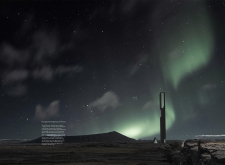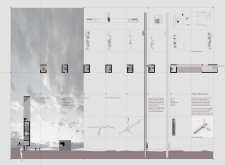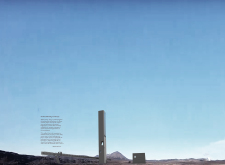5 key facts about this project
The architecture of Grípayr comprises a series of viewing platforms that orient toward significant geological features and expansive skies. It integrates elements of reinforced concrete, steel, glass, weathered timber, and natural stone to create a robust and enduring installation that withstands the rigors of the Icelandic climate. The layout encourages movement throughout the site, facilitating various perspectives that enhance visitor interaction with the environment.
The project stands out through its thoughtful integration of both terrestrial and celestial elements. The design focus on maximizing the visibility of astronomical events, particularly the northern lights, distinguishes Grípayr from conventional architecture. By placing the observational platform strategically, the design invites users to share a communal experience with the natural phenomena that define the region.
The architectural composition features vertical elements that engage with the expansive horizon. The tower serves as a landmark, not only guiding visitors but also framing views that emphasize the unique topography of Iceland. The choice of materials echoes the geological context, providing a tactile connection to the environment. Weathered timber cladding enhances the visual compatibility with the landscape, while glass elements ensure unobstructed views and promote transparency.
Grípayr emphasizes an architectural dialogue with nature, reinforcing the need for ecological sensitivity in design. The structure’s placement and design are the result of careful analysis of the site, ensuring minimal environmental impact while promoting cultural resonance. This project provides an innovative approach to engaging with landscape and context, highlighting the potential of architecture to enhance human connection to the natural world.
For a deeper understanding of the specific architectural designs and technical details, interested readers are encouraged to explore the project presentation to review architectural plans, sections, and further insights into Grípayr's design approach.


























